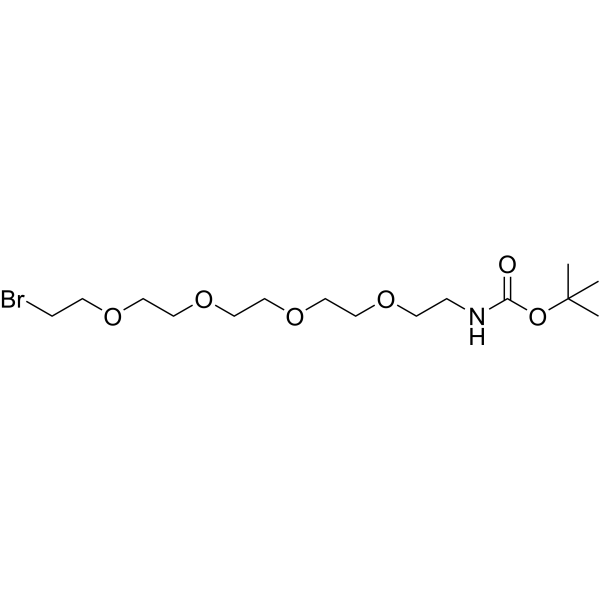
N-Boc-PEG5-bromide
CAS No. 1392499-32-9
N-Boc-PEG5-bromide ( —— )
产品货号. M26767 CAS No. 1392499-32-9
N-Boc-PEG5-bromide 是一种可裂解的 ADC 连接体,用于合成抗体药物偶联物 (ADC)。 N-Boc-PEG5-bromide 是一种基于 PEG 和烷基/醚的 PROTAC 连接体。
纯度: >98% (HPLC)
 COA
COA
 Datasheet
Datasheet
 HNMR
HNMR
 HPLC
HPLC
 MSDS
MSDS
 Handing Instructions
Handing Instructions
| 规格 | 价格/人民币 | 库存 | 数量 |
| 100MG | ¥340 | 有现货 |


|
| 200MG | 获取报价 | 有现货 |


|
| 500MG | 获取报价 | 有现货 |


|
| 1G | 获取报价 | 有现货 |


|
生物学信息
-
产品名称N-Boc-PEG5-bromide
-
注意事项本公司产品仅用于科研实验,不得用于人体或动物的临床与诊断
-
产品简述N-Boc-PEG5-bromide 是一种可裂解的 ADC 连接体,用于合成抗体药物偶联物 (ADC)。 N-Boc-PEG5-bromide 是一种基于 PEG 和烷基/醚的 PROTAC 连接体。
-
产品描述N-Boc-PEG5-bromide is a cleavable ADC linker used in the synthesis of antibody-drug conjugates (ADCs). N-Boc-PEG5-bromide is a PROTAC linker based on PEG and Alkyl/ether.(In Vitro):ADCs are comprised of an antibody to which is attached an ADC cytotoxin through an ADC linker. PROTACs contain two different ligands connected by a linker; one is a ligand for an E3 ubiquitin ligase and the other is for the target protein.
-
体外实验PROTACs contain two different ligands connected by a linker; one is a ligand for an E3 ubiquitin ligase and the other is for the target protein. PROTACs exploit the intracellular ubiquitin-proteasome system to selectively degrade target proteins. ADCs are comprised of an antibody to which is attached an ADC cytotoxin through an ADC linker.
-
体内实验——
-
同义词——
-
通路Others
-
靶点Other Targets
-
受体ACSS2
-
研究领域——
-
适应症——
化学信息
-
CAS Number1392499-32-9
-
分子量400.31
-
分子式C15H30BrNO6
-
纯度>98% (HPLC)
-
溶解度——
-
SMILESCC(C)(C)OC(=O)NCCOCCOCCOCCOCCBr
-
化学全称——
运输与储存
-
储存条件(-20℃)
-
运输条件With Ice Pack
-
稳定性≥ 2 years
参考文献
1.?Dixon, Darryl David, et al. Benzimidazole derivatives as ACSS2 modulators and their preparation. WO2015175845A1
产品手册




关联产品
-
Cinnamamide
Cinnamamide 是一种生化试剂,可作为生物材料或有机化合物,用于生命科学相关研究。
-
Icaritin
淫羊藿素具有激素调节活性和心血管功能改善活性。淫羊藿素具有抗癌活性,可诱导S期阻滞和细胞凋亡,抑制ENKL细胞增殖。
-
1-Hydroxy-2,3,4,7-te...
1-Hydroxy-2,3,4,7-tetramethoxy-xanthone has vasodilatory action, it can cause vasodilation in the coronary artery pre-contracted with 1uM 5-hydroxytryptamine (5-HT), with the EC 50 value of 6.6±1.4 uM.



 021-51111890
021-51111890 购物车()
购物车()
 sales@molnova.cn
sales@molnova.cn







